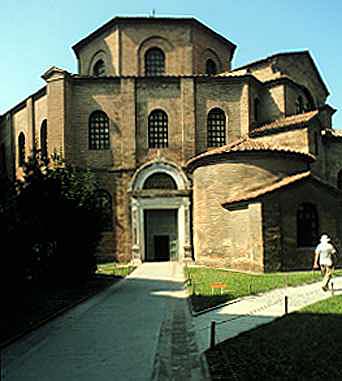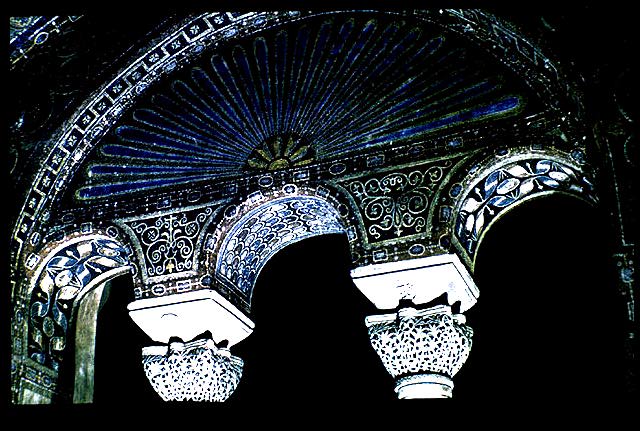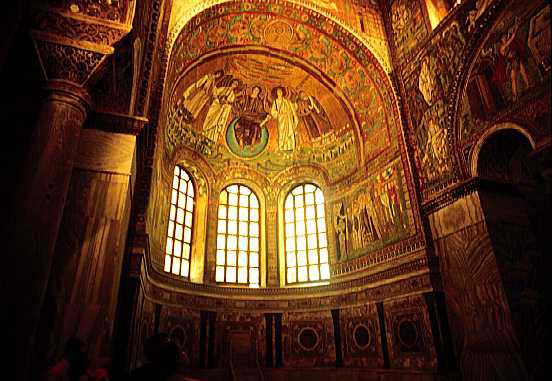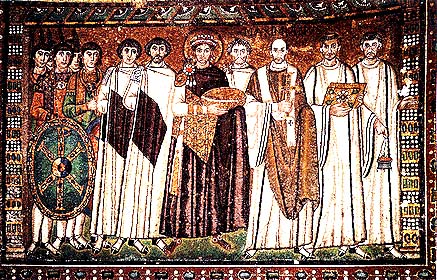Home
View My Guestbook
Sign my Guestbook
E-mail


Background of San Vitale || Mosaic
Art in Changing Times
Although art have significantly changed from the high Empire to the late antiquity, the change was gradual. I am not an art historian (though you can trust the information on my art pages) so I will not recount the process for you. If you really want a good guide for the transition from Roman period to the Medieval Period, I suggest general art history books. I personally have not come across any webpages that do an adequate job of it. In any case, the focus of this little section is the church of San Vitale in Ravenna.
 | San Vitale was began shortly after the death of the Ostrogothic King Theodoric. It was completed and dedicated by Bishop Maximianus in 547. One of the most unique feature of this church is that in its ground plans, it is two concentric octagons. It took me a while to figure out what this meant because I have never been there. Basically, the church has a large octagon as a base, and a second story of a small octagon is placed on top of it. The windows (called the clerestory) of the second/inner octagon provides much of the lighting for the church. What the double octagon does is that it basically make it a flowerlike formation. (Use your imagination). The fancy word for this eight-leafed design is octafoliate . |

I don't know if you can see it in the pictures here,
but notice that there is a sort of block between the arches and the capital
of the Corinthian columns. This is called the imposter blocks. (Stay
with me, I have a point). These blocks are common in churches of
Ravenna, but it is not seen in traditional Roman art. The entire
church is highly ornate. From top to bottom, literally not one inch
of space is left undecorated. Although Ravenna is located very close
to Rome, clearly, it is more influenced by the Byzantine style than the
Greco-Roman norm. Ravenna was made the captial of the Western
Empire, and although it remained for the most part independent of the Eastern
Empire, it's art links it back to Constainople, rather than Rome as seen
in its orientalizing styles.
| The mosaics of this church are regarded as some of the finest of Byzantine art. Most of the ones in and around the Eastern Empire were destroyed by the Christians there who thought having pictures of those sorts were like having icons and thus destroyed them. |  |
Thus, the only pocket of well preserved mosaic from this period comes from Ravenna. All the panels of mosaics are used to justify Justinian's rule of the Western Empire. All these mosaics are located very close to one another in the apse (although the scholars aren't sure exactly where the one with empress Theodora goes).

On the apse's vault, there is a picture of Second Coming or Christ Between Angels and Saints. Christ seated on the globe of the world flanked by three angels. One of the angels is presenting the Bishop Ecclesius. I'm not sure if you can see this, but his name is written above his head. There was a tradition of labeling humans. Under Bishop Ecclesius, the foundation of the church were laid. Here you see him presenting Christ with a miniature model of the church. This is a common motif that is used again and again. I don't have a picture of this, but the Justinian mosaic is located almost right below this .
 | The linking of the holy and Justinian is by no means subtle. Justinian can be distinguished no matter how little you know of history or art history because he is wearing a crown. More importantly he has a halo around his head, something usually reserved for Saints and angels. Also note that he is wearing the tradition color of purple (it's kind of an odd color here, and probably a different color on your monitor than mine, but trust me, it's purple), the color reserved for aristocratic Romans of days long ago. In this act, Justinian intentionally or unintentionally is evoking his connection with the past pagan Emperors. Although his agenda has always been one God, one Emperor, one Empire, Justinian seems himself as nearly holy very similar to the deification of the emperors of the past. Also notice that on the shield near Justinian, there is the symbol of Cho-ro instead of the cross. They stand for the first two letters of Jesus spelt in Greek. |